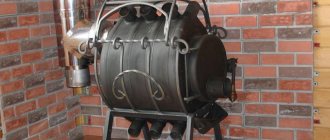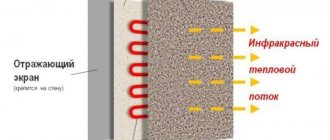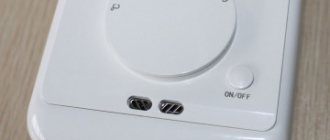An infrared heater refers to equipment that emits electromagnetic waves. Users unfamiliar with how such devices operate express concern about whether they have a negative impact on health. Marketers, in turn, present this type of heating as convenient, environmentally friendly and completely safe. If you follow the rules for using the equipment, there will be no harm to your health from the infrared heater.
Operating principle
Infrared (IR) or thermal radiation has a different wavelength from other types. This figure ranges from 0.78 to 1 micron. The frequency range is from 106 to 500 x 106 MHz. IR waves are completely inaccessible to human visual perception, but receptors on the skin can perceive them as thermal radiation.
IR radiation is also called thermal radiation. In nature, the most famous sources of such waves are the Sun (the most powerful) and humans.
Types of infrared wave bands:
- near - 0.8–2.5 µm;
- medium - 2.5–25 microns;
- far - 25–1000 microns.
The general rule of wavelength is that it is inversely proportional to its ability to pass through tissue, that is, a shorter wave is able to penetrate tissue structures faster. Infrared radiation is characterized by deep heating and penetration into objects.
IR waves are long, so they can be freely absorbed even in a room that is too cold and very windy. Heating of the room begins almost immediately after connecting the infrared device to the network. The speed of heating is explained by the fact that the radiation flow is directed to a specific area that needs to be heated.
The operating principle of an IR heater is similar to the interaction between the sun and the atmosphere. The sun's rays penetrate the surface, which absorbs heat, heats up, and then releases this energy.
The body of the IR device is made of steel, and powder paint is applied to the surface. Inside it is an aluminum reflector to which a heating element is attached. Externally, the device is similar to a heating panel or lamp, inside which a beam of infrared rays is concentrated, the action of which does not depend on the speed of movement and direction of cooled and warm air masses.
Choosing the right infrared heater
halogen heating element
Infrared heaters are available for sale with three types of heating elements:
- halogen;
- carbon;
- ceramic.
- The halogen emitter has two disadvantages - its golden light irritates the eyes and it emits short-wave heat, which has a negative effect on humans.
- In addition to thermal radiation, the carbon heating element emits some of its energy in the form of a reddish glow, which can be an irritant to vision and cause a negative reaction in asthmatics and allergy sufferers.
- Heating elements with a ceramic shell do not emit light, and their radiation falls in the harmless mid-wave and long-wave range.
film IR heater
An honorable second place, after convector heaters, in the overall rating was taken by film IR models. They are thin heating elements laminated with a special film. Their maximum heating temperature is 50 degrees. Such heaters are suitable for heating floors, panels, and ceilings. Due to the low heating temperatures, the wavelength emitted by the heater is in the range of 5–10 microns. Moreover, the main part of its wave spectrum falls on 9–10 microns, which coincides with the length of the thermal wave emitted by a person. Therefore, it is easily absorbed by the human body and, as it were, warms it from the inside.
One of the positive assets of IR film coatings is their ability to maintain a comfortable temperature, at which the air does not dry out and the oxygen content in it does not decrease. A large heating area promotes the formation of negative ions, which have a positive effect on the body.
Manufacturers of infrared heating equipment convince us of its complete safety. In fact, whether an infrared heater is harmful or not largely depends on the correct choice when purchasing and installing it.
local action of the IR heater
When choosing the power of an infrared heater, focus on the ratio of 1 kW for every 10 sq. m. area to be heated. But this is only the case when this unit will be the main source of heat.
For short-term local heating, the best option would be low-power IR emitters, about 3 kW, with carbon or quartz heaters. Their heat transfer is much more efficient. If you just need an additional heat source, then the power can be reduced.
When choosing the option for ceiling mounting of the heater, make sure that the distance from it to your head is from 0.7 to 1 meter. If you place the device too low, you will get headaches and poor health. You will have to reinstall the heater or change the work area.
In other words, the harm of an infrared heater is “not programmed” in the principle of its operation, but may be caused by its incorrect installation or excessively long use. Infrared heating technology is economical, easy to operate, and it is not without reason that it is called the climate control technology of the future.
The article was written by Svetlana Semyonovna Dracheva, a physics teacher of the highest qualification category.
Why is it harmful to the body?
Some experts claim that radiation has a negative effect on the human body; they claim that the waves cause diseases of the eyes, skin, as well as the nervous system and blood. Other experts say that infrared heat is good for health: it has a positive effect on metabolism, skin and muscles. However, there are independent studies that show that the waves emitted by emitters are harmful.
In case of prolonged exposure to infrared, the eyes become more susceptible to harmful radiation, and headaches may begin. In extreme cases, with extremely prolonged exposure, cataracts can occur as a result of the initiation of chemical processes in the white of the eye. It is worth noting that infrared radiation with short waves, quickly penetrating through tissue, reaches the structures of the eye faster.
Far infrared light is used to heat rooms in which people are located. This is radiation that is easily absorbed by particles of liquid that are present in the human body. Therefore, cells (especially skin) are heated in a certain sense directly and quite quickly. But the power emitted by the heater is small. This range is considered completely safe, as confirmed by studies presented by the manufacturers.
According to scientific research, only long-wave infrared devices have a positive effect on the human body. But this process should be short-term. Otherwise (with prolonged directed heating), according to professionals, the skin will be overheated and dry out, which will have a bad effect on its condition. In addition, it is possible to burn the retina and lens of the eye, so experts do not recommend looking at the heater coil for a long time.
The benefits of infrared rays for humans
Long-wave infrared rays are beneficial to human health. It is often used in medicine, particularly in physiotherapeutic procedures, which can improve blood circulation, metabolism and neuroregulation.
The positive effect of infrared radiation on the human body is as follows:
- memory and brain function improves,
- blood pressure is normalized,
- hormonal balance is normalized,
- salts, toxins and heavy metals are eliminated,
- the proliferation of fungi and harmful microorganisms stops,
- water-salt balance is restored,
- pain relief occurs
- an anti-inflammatory process occurs
- cancer cells are suppressed
- the results of radioactive radiation are neutralized,
- insulin increases in diabetic patients,
- dystrophy is cured,
- psoriasis goes away,
- immunity is strengthened.
Heating using infrared rays kills harmful bacteria and helps strengthen the immune system. Air ionization protects against allergic manifestations. Long waves of infrared heat have a calming effect on fatigue, irritability, stress, promote wound healing, and lead to recovery from the flu.
Is there any benefit
We can say that one of the undoubted advantages of infrared heating is its positive effect on the human body, as well as on the condition of buildings.
The benefits are as follows:
- The rays do not cause air or dust movement. This may be especially important for people with allergies.
- The heat emitted by the device is absorbed by the floor, walls, and ceiling, as a result there are no problems with high humidity in the room, and the risk of mold or mildew is reduced.
Types of devices
Devices that emit infrared rays require certain power sources to operate.
There are the following types of infrared devices based on the type of heating element:
- Electric. This heater, when reaching a higher temperature (about 2200 °C), emits short infrared rays IR-A with a wavelength of about 1.2 microns. They are not visible to people, but their radiation is felt as a thermal impression, that is, an increase in temperature. The heater is a radiant/infrared filament which is made of a gold plated glass tube with a tungsten filament. The entire radiator is filled with gas. 92% of the energy consumed by a radiator is reflected in the form of noticeable heat. The service life is 7000 hours. The number of starts and stops does not negatively affect the emitter.
- Gas. These devices have a significantly greater heat capacity and impressive dimensions; their height can reach 15-20 meters. The models work on the same principle as electric ones, but use gas as an energy source.
- Diesel, kerosene. They are used in the construction of large facilities and are involved in the technological process of drying wood. The power of such devices is comparable to gas models, but they are more compact and can be reconfigured to work in any conditions.
- Ceramic. Equipped with a ceramic plate that does not emit visible light. The mid-wave infrared (IR) radiation emitted by these devices has a wavelength of 2 to 10 microns. The source temperature, depending on the power, ranges from 272 to 726 °C. The power of one emitter ranges from 150 W to 1000 W. It provides heat directly to the person and all objects within the range of the heating element.
Most often, electric and ceramic models are chosen for apartments and private houses.
There are three types of IR heaters based on heating level:
- Emitting long waves. This type of device is installed in private households, offices and small industrial premises.
- Average. Used in buildings with high ceilings - more than 3 m.
- Short. The equipment is used exclusively in industrial workshops, large halls with high ceilings, or outdoors. The models are not suitable for home use, since their radiation is the strongest.
How to avoid the harmful effects of IR rays
So, we already know that short-wave radiation is the most dangerous for humans. Now it remains to find out where it can lie in wait for us. First of all, the sources of such radiation can be bodies whose temperature is more than 100°C. It can be:
- Industrial sources of beam energies. These include steelmaking furnaces and electric arc furnaces. In order to protect the personnel serving such enterprises, it is necessary to issue protective equipment, install heat-protective screens, improve the production process, and carry out therapeutic and preventive measures on an ongoing basis.
- Heating devices. If previously the Russian stove was popular among the population, the heat of which was extremely comfortable and also had healing properties, then such a detail is alien to modern people. Wonderful stoves have been replaced by electric-powered heaters. They can also be divided into “useful” and “harmful”. Thus, models whose spirals are insulated with a special material emit favorable and soft heat into the environment, but options with open heating elements generate the notorious short infrared waves, whose abilities we already know. Manufacturers must indicate the nature of the emitted waves.
IMPORTANT! If you already have a heater with open coils. Remember that the closer it is to you, the less time you need to keep it on.
How to choose a good one
IR heaters operate on a principle that can be compared to sunlight. While oil and convection heaters heat the air in the immediate vicinity, IR heaters fire rays that raise the temperature of objects they encounter along the way. Only the heat of solid objects heated in this way increases the air temperature.
In the case of infrared heating using panels, objects and people again reflect the accumulated heat, thereby ensuring comfort throughout the entire room with an even temperature distribution.
According to the installation method, heaters are distinguished:
- ceiling;
- floor, baseboard;
- wall-mounted
Blocks that are attached to the ceiling are most in demand today, as they completely eliminate the effect of convection and do not tolerate dust. In addition, the mounted device does not require much space; it is mounted in a suspended ceiling or attached to a conventional one using brackets.
Floor-standing electrical appliances are less efficient than ceiling-mounted ones, because their radiation flow is not directed directly, thereby making heating more difficult. For home use, it is best to choose progressive carbon devices. Their heating elements are made in the form of a quartz tube with a carbon spiral inside. Although during operation they emit a reddish glow that is not very pleasant for the visual organs. The ceramic element does not glow as well, but is inferior in quality.
Some IR wall heaters consume less electricity than other devices. They heat semi-closed rooms and open areas well.
Portable models are compact in size, but can heat a much smaller area than stationary ones.
Modern infrared devices are of the following types:
- Quartz. They are the safest for use (the temperature of the heated elements is 450–500 ºС). Quartz glass serves as a radiation filter.
- Halogen. Not recommended for use in residential buildings, suitable only for large spaces (elements temperature is 2000 degrees). Gas is pumped inside the flask; if it is damaged, the substance can be hazardous to health.
- Carbonaceous. Devices with a spiral are considered reliable and durable, resistant to elevated temperatures (carbon elements are heated to 600–700 degrees).
- Micathermic. These new products are characterized by the highest efficiency and safety. Covered with a mica plate, the element is heated to 60–80 degrees. The reliability of this type of heating equipment for the home has been tested in practice.
- Ceramic. Thin wall panels come in a variety of shades. The model can be matched to any interior. They are installed in apartments and houses after renovation, where it is necessary to carefully install the heating system without spoiling the finish.
- Steel. Such devices use a metal radiating panel. Outwardly, they resemble fluorescent lamps. Their main advantage is their small thickness.
- Film. The most original and beautiful models. Produced in the form of unfolding pictures. They look great and are suitable for temporary heating.
If you are already planning to purchase a heating device, it is recommended to choose devices with long-wave radiation. Such models do not pose a danger to people during operation.
Basic principles of infrared heating
Many who hear the word “radiation” experience some kind of rejection due to associations with something bad and harmful, but there is no need to be afraid of the word itself.
Radiation is the transfer of energy by emitting electromagnetic waves. These can be solar rays, as well as heat flows that can be emitted by any heated object in our environment.
One of the most famous examples, as you already understood, is the sun. Such a phenomenon as, for example, solar radiation is called “thermal radiation”.
When a heat flow, spreading from a source object, reaches other bodies, part of it is reflected, and part is absorbed by them. When other objects absorb the energy of thermal radiation, it turns into the internal energy of these objects, and they heat up.
In practice, there are three main types of IR waves:
- Short wavelengths are waves from 0.8 to 3 micrometers that appear at temperatures of 800° and above
- Medium wave - from 30 to 50 microns, at temperatures from 300 to 800°
- Long wavelength - from 100 to 200 microns, at temperatures up to 300°
Short-wave fluxes emitted by high-power heating elements at high temperatures are considered dangerous to human health.
The safest and best option for residential premises is long-wave radiation, which coincides with the radiation of the human body, which perceives it as its own and easily absorbs it.
When a person is exposed to a long-wave stream, he begins to feel better, relieve fatigue, and improve blood circulation.
This method is often used in medicine. For example, in the West, for heating newborn children, or in Japan, in health centers for the elderly.
In Russia, the analogue of these technologies has always been the Russian stove, which, after heating, gave off dry heat for a long time and served as a good aid in folk medicine. Lying on the stove, people often treated colds and more.
Safety precautions
Installation and connection of the heater must be carried out only in accordance with safety regulations. If the technical requirements are met, the device will be safe for health even with prolonged use - 24 hours a day.
Forbidden:
- operate the heater without grounding;
- use the device in rooms with the presence of flammable liquids, steam-air mixtures, flammable dust or fibers, in very dusty rooms and during repairs;
- wipe the radiating plates with flammable liquids while the heater is operating;
- install the heater next to furniture and curtains;
- leave the device turned on unattended;
- use a clothes dryer.
You should purchase original devices from trusted manufacturers, made of quality materials.
Methods of protection
To reduce the negative impact of a heater on health, you need to follow a few simple rules.
Helpful Tips:
- Do not place the heater directly above a place where people are constantly present; it is better to install it in the far corner of the room.
- Avoid sleeping near short-wave infrared light as it may cause dry skin.
When choosing a heater, you don’t need to give preference to the cheapest options. The cost of such a device can only be reduced by using low-quality materials that release hazardous elements into the air when heated.
Popular myths
Before assessing whether infrared heaters are harmful to humans, it is necessary to clarify which devices we are talking about. There is a large group of models that differ in their characteristics.
Floor, wall and ceiling infrared heaters, the whole truth and myths:
- With the help of IR heaters, many diseases can be cured. This is not true. When the equipment is used correctly, the rays have a positive effect to some extent, but they cannot cure a person of an illness. The device cannot be used as a medicine for serious pathologies.
- Users sometimes confuse infrared radiation with another - x-ray ultraviolet. Experts have long proven that IR devices do not have any particular negative impact. The devices emit heat waves of the same length as the human body.
- When using infrared heating devices, you can get cancer. This fact has not been proven at all. Although long-term exposure to infrared radiation negatively affects the skin, the development of malignant tumors does not occur.
Reviews from doctors
Yes, there are health risks from infrared radiation, but this occurs when heaters are not used properly. So when weighing the pros and cons of infrared heat, just remember: “it’s the dosage that separates the medicine from the poison.”
Gunkov I.N.
Even if the device was selected according to the area of the house, this cannot be a guarantee of absolute safety. The device is harmful if used for a long time, especially if it was installed in violation of safety regulations. Even if there are no serious consequences, the eyes and skin may be damaged.
Ivanov N.F.
With frequent and long-term use of such heating devices, negative consequences from exposure to infrared rays may occur. Here you need to take into account the type of device, choose a heating device that emits long waves. But for patients with weakened immune systems, the influence of such a heating device is sometimes even beneficial.
Romanenko I.I.
Harm of IR radiation
The issue concerning the negative effects of infrared radiation on humans has occupied many leading scientific and medical figures. Numerous studies have been conducted that have shown that these heaters can, in some cases, have a negative impact on human health.
Attention: The greatest harm from infrared heaters is associated with overdrying of the skin, which heats up very quickly, after which moisture evaporates, which the body is not able to quickly restore.
If you stay in close proximity to such a heater for a long time, you can get burns. After all, at a short distance, this heating device emits waves that are the most dangerous.
Infrared radiation is always present in any production. People who are in the workplace are regularly exposed to it. If the skin is not protected by clothing, then with daily exposure changes occur within its structure. In particular, the permeability of cell membranes decreases, protein melting occurs, which is irreversible, and the appearance of blood cells changes.
The eyes also suffer from radiation. Especially the retina and lenses. Because of this, vision may deteriorate. In addition, cataracts may develop in the future.
To heat various outdoor objects, heaters that emit short or long waves are most often used. They can be installed in gazebos, cafes, and summer areas. If such a device is installed indoors, a person regularly exposed to radiation can get quite severe burns. Often, skin redness and blisters appear.
Scientists' opinion
The results of recent scientific research have confirmed the positive effects of long-wave infrared rays on human health and immunity. But this applies to short-term exposure. Otherwise (with prolonged directed heating), doctors say, the skin is overheated and dried out, which has a detrimental effect on its condition. In addition, burns to the retina and lens are possible, so experts strongly do not recommend looking at the heated elements of heaters.
Everything in moderation
It will be useful to warm up near a heat source when you come in from the cold, but sleeping in the immediate vicinity of an IR heater is harmful and dangerous. A working appliance hanging from the ceiling or standing in the corner of a room will cause just as much harm as a fireplace. You're not afraid to sit by the fire, are you? But an open flame is a powerful source of infrared radiation.











